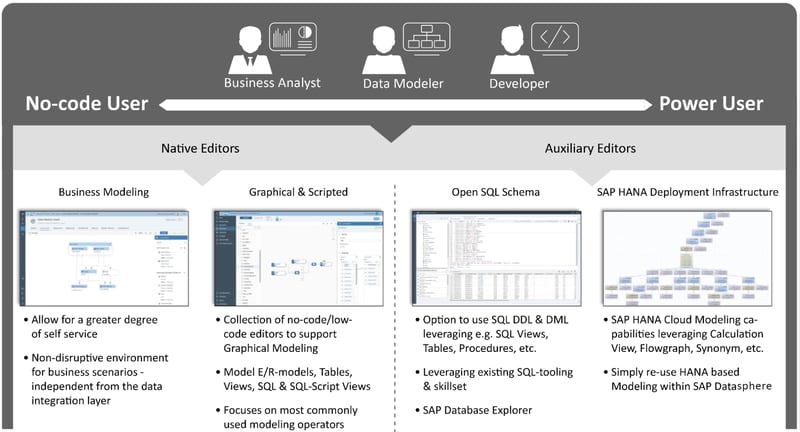Data Mesh is a new architectural paradigm that has been gaining popularity in recent years. It provides a decentralized and scalable approach to managing large and complex data landscapes. In October 2022, we wrote a blog that delved deeper into the topic of Data Mesh, highlighting two key principles: Federated Governance and Self Service Platform. In this article, we will explore how these principles are relevant to the SAP Datasphere.
Datasphere [formerly known as SAP Data Warehouse Cloud (DWC)] is a cloud-based data warehousing solution that provides a modern and unified solution for businesses to analyze and manage their data. This article will show how Datasphere provides a technological platform that supports Federated Governance and Self Service Platforming, showing its potential as a key tool in your Data Mesh landscape.
Governance in Datasphere.jpg?width=400&height=385&name=Data%20Mesh%20DWC%20(1).jpg)
The core concept of "Spaces" in Datasphere allows us to configure centralized governance of all Datasphere artifacts. Spaces allow the definition of segregated areas within a Datasphere tenant. Each Space hosts its own modeling objects, user mappings and permission settings. At the same time it is possible to “share” the modeling objects and their contained data virtually and as read-only among the Spaces. This enables a number of use cases, such as defining separate Spaces for each data product team in a data mesh-supported business intelligence organization. Spaces that can also be defined include central IT areas that are closed to non-technical users, department-specific Spaces that restrict access to sensitive personnel or financial data, and personal Spaces for users to create prototypes. If needed, all of these Spaces can share data with each other on an artifact granularity and without duplication, so there are no additional performance or storage costs. This technical architecture allows organizations to flexibly implement their governance requirements within Datasphere.
Democratize Data Modeling
With Datasphere, data modeling is now not only reserved for traditional developers and power users, but is also supported and enabled for business users. Developers can choose from a variety of tools depending on their preferences, technical knowledge and use case. This flexibility in serving various user groups enables Datasphere to be used as a Self Service Platform.

The support of the HANA Deployment Infrastructure (HDI) enables very powerful modeling options, as this leverages the capabilities of HANA cloud modeling in addition to the native tools of Datasphere. Furthermore, access to the underlying Open SQL schema is possible, allowing developers to use database-level SQL commands.
The native data modeling options can be divided into two different approaches: the Business Builder and the Data Builder. These are UI (User Interface) perspectives, each containing a unique set of object types.
Watch the recording of our webinar:
The Data Builder perspective is aimed at data engineers and other technical professionals, as we are used to from BW or native HANA modeling, and supports the creation of tables, graphical and scripted views, and data flows, among other things.
The Business Builder is designed to provide modeling functionality to business users by focusing on business terminology instead of technical terms, as well as intuitiveness and a more guided modeling experience. The underlying design ensures a seamless collaboration between business and IT, as business users work exclusively on virtual, semantic levels.
Putting it into practice
These two core aspects of democratized data modeling and governance capabilities through Spaces set the technological groundwork for pursuing a data mesh architecture.
A common approach, therefore, is for IT to integrate data sources, manage replication and federation of data, and create a basic model for each business unit in the Data Builder. Then, business users are given access to add their own virtual models to the existing base. This significantly increases the efficiency and flexibility of the overall business intelligence workflow.
The combination of the Business Builder and the Spaces concept of SAP Datasphere means that the departments become more independent of central IT and the individual users, as well as entire departments, are in a position to create prototypes and scenarios independently without endangering the stability of central reporting.
Stability and agility can thus coexist in one system and offer the best of both worlds. The business departments get the flexibility they need for their reporting, while the IT department maintains centralized management, data quality and security.
Our Conclusion - SAP Datasphere and Data Mesh
In summary, SAP Datasphere provides a technological platform that supports two of the key principles of Data Mesh with Federated Governance and Self Service Platforming. The core concept of Spaces in Datasphere enables centralized governance of all Datasphere artifacts, while the democratization of data modeling through the Business Builder and Data Builder perspectives empowers business users and technical professionals to collaborate efficiently in the creation of data models. However, it is important to note that while Datasphere is a useful tool to facilitate a Data Mesh Architecture, it cannot replace the Change Management process needed to enact the sociocultural changes within organizations to facilitate a sense of Domain Ownership and treating data as a product, which are also key principles on the journey towards a Data Mesh Architecture.
If you’d like to discuss your organizations’ specific needs and whether SAP Datasphere and data mesh could be beneficial for you, we’re eager to learn about your challenges and happy to help finding and implementing optimal solutions. Request a non-binding consulting offer today.
Data Science & Engineering, SAP Data Warehouse, Datasphere

/Logo%202023%20final%20dunkelgrau.png?width=221&height=97&name=Logo%202023%20final%20dunkelgrau.png)
























